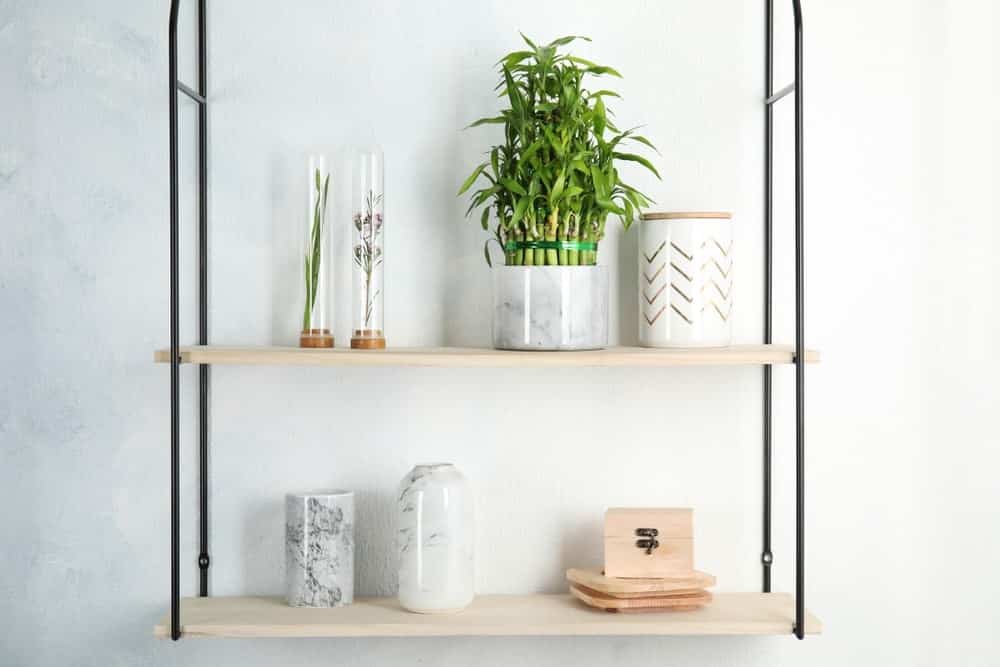This is a plant that is made up of the cut stalks of a Dracaena Saderiana. It is native to Eastern Asia and West Africa.
The followers of Feng Shui believe that it will bring good fortune and prosperity to the business or home. They are a plant that requires very little are and can grow about anywhere as long as you keep it chemical-free and the water clean.
Lucky Bamboo Care and Growing Guide
1. About Lucky Bamboo Plants
This unusual and fascinating houseplant is an attention-getter. It can be grown in soil but many grow it in water. Although it has the name Lucky Bamboo plant, it is really not bamboo. If you have an arrangement with three stalks, it will bring happiness, with five stalks it will bring wealth, and with six stalks it will bring health. They do not use four stalks because the word four sounds too close to the word death in Chinese.
2. Light Requirement
The Lucky Bamboo plant needs bright indirect light but it can survive in medium and even lower light. Make sure that you do not put your plant in direct sunlight as it will scorch the leaves. They are more tolerant of having not enough light than having too much light.
3. Water
Most Lucky Bamboo plants are grown in water. They are put in clear or opaque vases or containers so you can see the entire plant. Before you put your plant in the container, you need to put some pebbles or marbles at the bottom of the container to anchor the plant.
When watering your plant, all you need to do is make sure that the pebbles or marbles are covered with water. To keep the water at the right level you need to add water once a week. There should be about an inch of water in the container.
To keep the water fresh, once a week take the Lucky Bamboo plant out and clean the container and rinse off the pebbles or marbles. Once this is done, just put it back together. Do not use water that is high in chlorine or fluoride so you should use distilled or bottled water instead of tap water. If you have to use tap water, it has to be left out for at least 24 hours so the chlorine in it can evaporate. Seeing red roots is normal.
4. Fertilizer
During spring and summer, you need to fertilize once a month. Use an African Violet plant food that has been diluted to half the strength that is recommended.
5. Soil
Although many keep their Lucky Bamboo plant growing in the water you can also plant them in loose-quick-draining soil. Before you water them, you need to let the top few inches dry out.

6. Temperature
This plant needs temperatures between 70-85 degrees Fahrenheit and basic household humidity. Do not sit your plant in front of a drafty window, air conditioner, or heating vents.
7. Climate
If you grow it outdoors, you can plant them in zones 10 and 11
8. Speed of Growth
It will grow about 19 inches in six months in 10-20 steps so each step takes about two to three weeks. The leaves may grow at the rate of an inch a month.
9. Height and Spread
As a houseplant, it can grow to approximately two to three feet but you can get some that are shorter.
More like this: Baby Tears: Plant Care and Growing Guide
10. Flowers
Outdoors, the flowers that the Lucky Bamboo plant produces only appear at night. There is a bloom that is made of many small flowers, which have a slight scent. They do not produce flowers if an indoor plant.
Also read: ZZ Plant Care & Growing Guide
11. Trimming
When you trim your Lucky Bamboo plant, you want to remove any of the off-shoots in order to preserve the intricate shape of the plant. The cut areas are where the new growth develops. If you do not want any new growth, you can prevent this by covering the cut area with paraffin.
If you want to shape your Lucky Bamboo plant, you just need to rotate it in from of a light source occasionally because this will get the plant to naturally grow toward the source of light.
Is Lucky Bamboo Poisonous?
They are mild to moderately toxic to children and pets.
Common Lucky Bamboo Diseases
- Pale leaves: The plant is not getting enough light
- Yellow leaves: Excessive fertilizer or too much sun
- Green is fading or the plant seems to be stretching: It needs more light
- Dead plant: It could be the water is chlorinated or there could be bacteria in the water from letting dead leaves rot in the water
- Brown leaves: This can mean polluted water or dry air.
- Algae: This can happen if you have it potted in a clear container that allows the light to come inside and encourage algae growth. This is why you need to change the water and clean the container once a week. Just clean out the container and put it back inside. You can also use an opaque container if this keeps happening.
As an indoor plant, it is pretty much pest resistant but if you see any you can wipe them off with a damp cloth or pick them off. If you notice that the stalks are getting mush or starting to rot, you need to take it out immediately. You can try to save it by cutting away the yellow parts and try to root it in new water.
Keep reading: Aloe Vera: Plant Care and Growing Guide
Conclusion
Depending on where you purchase your Lucky Bamboo from, some will be sold as individual sticks so you can choose how many you want to bundle together for the type of luck you want to have and others are already tied together. If they are already tied together, do not untie them because the ties stabilize the plant.
You can find Lucky Bamboo plants almost everywhere today. They are found in offices on desks and homes because they are so easy to grow, especially in water. And when grown in water, it makes them so much easier to take care of.
Learn more:
- Clematis Care & Growing Guide
- Peperomia Plant Care & Growing Guide
- Monkey Tail Cactus: Plant Care & Growing Guide
Victoria is the owner and main author of hobby plants. She loves spending her free time in her garden planting and taking care of her plants. Victoria hopes you enjoy the content here!
![Why Is My Bamboo Plant Turning Yellow? [Find Out Here] Why Is My Bamboo Plant Turning Yellow? [Find Out Here]](https://www.hobbyplants.com/wp-content/uploads/2022/07/why-is-my-bamboo-turning-yellow-300x158.jpg)


![Mother Of Thousands Plant [Complete Plant Care Guide] Mother Of Thousands Plant [Complete Plant Care Guide]](https://www.hobbyplants.com/wp-content/uploads/2022/07/mother-of-thousands-plant-300x158.jpg)
![Majesty Palm Plant Care: [Complete Beginner's Guide] Majesty Palm Plant Care: [Complete Beginner's Guide]](https://www.hobbyplants.com/wp-content/uploads/2022/08/majesty-palm-care-300x158.jpg)
![Exotic Angel Plant Care: [Complete Beginner's Guide] Exotic Angel Plant Care: [Complete Beginner's Guide]](https://www.hobbyplants.com/wp-content/uploads/2022/08/exotic-angel-plant-care-300x158.jpg)
![Snow White Waffle Plant: [Complete Care Guide] Snow White Waffle Plant: [Complete Care Guide]](https://www.hobbyplants.com/wp-content/uploads/2022/08/snow-white-waffle-plant-300x158.jpg)
![Waffle Plant Care: [Complete Beginner's Guide] Waffle Plant Care: [Complete Beginner's Guide]](https://www.hobbyplants.com/wp-content/uploads/2022/08/waffle-plant-300x158.jpg)
![Bird Of Paradise Plant Care: [Complete Beginner's Guide] Bird Of Paradise Plant Care: [Complete Beginner's Guide]](https://www.hobbyplants.com/wp-content/uploads/2022/08/bird-of-paradise-plant-300x158.jpg)
![Purple Passion Plant Care: [Complete Beginner's Guide] Purple Passion Plant Care: [Complete Beginner's Guide]](https://www.hobbyplants.com/wp-content/uploads/2022/08/purple-passion-plant-care-300x158.jpg)
![China Doll Plant Care: [Complete Beginner's Guide] China Doll Plant Care: [Complete Beginner's Guide]](https://www.hobbyplants.com/wp-content/uploads/2022/09/china-doll-plant-care-300x158.jpg)
![Polka Dot Plant Care: [Complete Beginner's Guide] Polka Dot Plant Care: [Complete Beginner's Guide]](https://www.hobbyplants.com/wp-content/uploads/2022/09/polka-dot-plant-300x158.jpg)